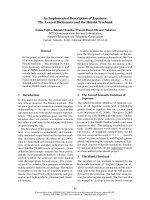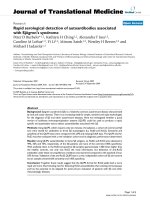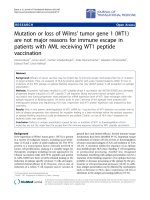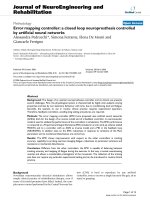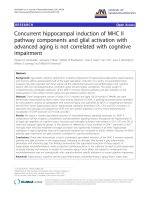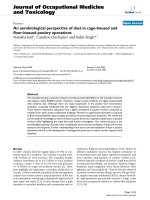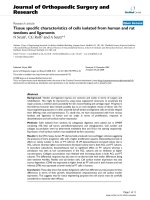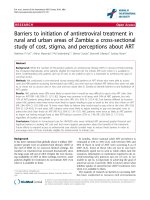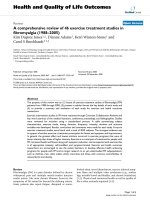Báo cáo hóa học: " Improvement for detection of microcalcifications through clustering algorithms and artificial neural networks" ppt
Bạn đang xem bản rút gọn của tài liệu. Xem và tải ngay bản đầy đủ của tài liệu tại đây (664.67 KB, 11 trang )
RESEARCH Open Access
Improvement for detection of microcalcifications
through clustering algorithms and artificial neural
networks
Joel Quintanilla-Domínguez
1,3*
, Benjamín Ojeda-Magaña
1,2
, Alexis Marcano-Cedeño
1
, María G Cortina-Januchs
1,3
,
Antonio Vega-Corona
3
and Diego Andina
1
Abstract
A new method for detecting microcalcifications in regions of interest (ROIs) extracted from digitized mammograms
is proposed. The top-hat transform is a technique based on mathem atical morphology operations and, in this
paper, is used to perform contrast enhancement of the mi-crocalcifications. To improve microcalcification
detection, a novel image sub-segmentation approach based on the possibilistic fuzzy c-means algorithm is used.
From the original ROIs, window-based features, such as the mean and standard deviation, were extracted; these
features were used as an input vector in a classifier. The classifier is based on an artificial neural network to identify
patterns belonging to microcalcifications and healthy tissue. Our results show that the proposed method is a good
alternative for automatically detecting microcalcifications, because this stage is an important part of early breast
cancer detection.
Keywords: detection of microcalcifications, top-hat transform, possibilistic fuzzy c-means clustering algorithm, artifi-
cial neural networks
1 Introduction
Breast cancer is one of the most serious types of cancer
that affects women around the world. It is also one of
the leading causes of mortality in middle-aged and
elderly women. The International Agency for Research
on Cancer (IARC) estimat es that more than 1 million
cases of breast can cer occur world -wide each year, with
some 580,000 cases occurring in developed countries
and the remainder in developing countries. The risk of a
woman developing breast cancer during her lifetime is
approximately 11% [1]. Early detection of breast c ancer
is of vital importance to successful of treatment, with
the main goal of in creasing the probability of survival
for patients. Currently, the most reliable and practical
method for early detection and screening of breast can-
cer is mammography. Microcalcifications (MCs) can be
an important early sign of breast cancer; they appear as
bright spots of calcium deposits. Individual MCs are
sometimes difficult to detect because of the surrounding
breast tissue and variations in shape, orientation, bright-
ness and diameter [2]. MCs are potential primary indi-
cators of malignant types of breast cancer. Therefore,
their detection can be important in preventing and
treating the disease. However, it is still difficult to detect
all MCs in mammograms because of the poor contrast
against the tissue that surrounds them.
Many methodologies have been presented by different
authors to detect the presence of MCs in mammograms.
These methodologies involve image processing techni-
ques, pattern recognition methods and artificial intelli-
gence approaches. Vega-Corona et al. [3] proposed a
method for detecting MCs in digitized mam-mograms.
The method consists of imag e enhancement by adaptive
histogram equalization to improve the visibility of MCs
with respect to the background, processing by multiscale
wavelets and gray-level statistical techniques for feature
extraction, clustering by the k-means algorithm for MC
detection and, finally, using feature selection and a clas-
sifier based on a general regression neural network
(GRNN) and multilayer perceptron (MLP) to classify
MCs. Papadopoulos et al. [ 4] compared five image
* Correspondence:
1
Technical University of Madrid, 28040 Madrid, Spain
Full list of author information is available at the end of the article
Quintanilla-Domínguez et al. EURASIP Journal on Advances in Signal Processing 2011, 2011:91
/>© 2011 Quintanilla-Dominguez et al; licensee Springer. This is an Open Access article distributed under the terms of the Creative
Commons Attribution License ( which permits unrestricted use, distribution, and
reprodu ction in any medium, provided th e original work is properly c ited.
enhancement algorithms for improving MC cluster
detection in mammography. Halkiotis et al. [5] proposed
mathematical morphology forMCextractionfroma
non-uniform background; in this scheme, a set of fea-
tures is extracted from original mammograms to test
two classifiers based on artificial neural networks, such
as MLP, and a radial basis function (RBF) neural net-
work.Fuetal.[6]proposedamethodbasedontwo
stages. The purpose of the first stage is to locate the
suspected MCs; this stage is based on mathematical
morphology and bo rder detection to segment the MCs.
The second stage is based on feature extraction and
selection from the MCs located in the first stage; in the
final part of this latter stage, these features are used as
an input vector to test two classifiers based on a GRNN
and support vector machine (SVM).
In this paper, a method for detecting MCs in the
regions of interest (ROIs) extracted from digitized mam-
mogramsispresented.Themainpurposeofthis
method is to provide an automatic MC detection system
that can help radiologists to improve the diagnosis of
breast cancer at an earl y stage. The method is based on
image processing, pattern recognition and artificial intel-
ligence techniques. The different stages of the method
are as follows: image enhancement based on mathemati-
cal morphology operations, a novel image sub-segmenta-
tion approach based on possibilistic fuzzy c-means
(PFCM) algorithm, which is compared with image seg-
mentation by the k-means algorithm, feature extraction
based on window-based features such as the mean and
standard deviation and, finally, the use of a classifier
based on an artificial neural network (ANN) to automa-
tically detect MCs. Figure 1 shows a block diagram of
the proposed method.
2 ROI image enhancement
Over the past several years, methodologies have been
developed for the detection and/or classification of
MCs, but the interpretation of MCs continues to be a
difficult task mainly because of their fuzzy nature, low
contrast and low dis-tinguishability from their surround-
ings. The difficulty of MC detection depends o n factors
such as size, shape and distribution with respect to MC
morphology. Another important factor that also makes
MC detection difficult is the fact that MCs are often
located across non-homogeneous backgrounds, and
owing to their low contrast against the background,
their intensity may be similar t o that of noise or other
structures [7,8]. Therefore, in this paper, it is co nsidered
important to apply image enhancement.
Mathematical morphology is a discipline within the
field of image processing that involves the structural
analysis of images. The geometrical structure of an
image is determined by locally comparing it with a pre-
defined elementary set called a stru cturing element (SE).
Image processing using morphological trans-formations
is a process of information removal based on size and
shape. In this process, irrelevant image content is selec-
tively eliminated; thus, essential image features can be
enhanced. Morphological operations are based on the
relationships between two sets: an input i mage, I, and a
processing operator, the SE, which is usually much
smaller than the input image. By selecting the shape and
size of a structuring element, different results can be
obtained in the output image. The fundamental mor-
phological operations are erosion and dilation.
The contrast can be defined as the difference in inten-
sity between an image structure and its background. By
combining morphological operations, several image pro-
cessing tasks can be performed; however, in this work,
we focus on those morphological operations that achieve
contrast enhancement. In [8], a contrast enhancement
technique using mathematical morphology is presented,
called morphological contrast enhancement. Morpholo-
gical contrast enhancement is based on morphological
operations known as top-hat and bottom-hat trans-
forms, which were proposed in [9] . A to p-hat is a resi-
dual filter that preserves those features in an image that
Figure 1 Block diagram of the proposed method.
Quintanilla-Domínguez et al. EURASIP Journal on Advances in Signal Processing 2011, 2011:91
/>Page 2 of 11
can fit within the structuring element and removes
those that cannot; in other words, the top-hat transform
is used to segment object s that differ in brightness from
the surrounding background in images with uneven
background intensity. The top-hat transform is defined
by the following equation:
I
T
(
x, y
)
= I
(
x, y
)
− [
(
I
(
x, y
)
SE
)
⊗ SE
]
(1)
where I(x,y)istheinputimage,I
T
(x,y)isthetrans-
formed image, SE is the structuring element, Ө repre-
sents the morphological erosion operation, ⊕ represents
the morphological dilation operation, and - represents
the image subtraction operation. [(I(x, y) Ө SE) ⊕ SE]is
also known as the morphological opening operation. In
previous works such as [8,10], this technique was used
to obtain satisfactory results in MC detection.
3 Image segmentation by partitional clustering
algorithms
Image segmentation is an important task in the field of
image processing and computer vision and involves the
identification of objects or regions with the same fea-
tures in an i mage. The aim of image segmentation is to
divide an image into non-overlapping subregions that
are homogeneous with respect to some features such as
gray-level intensity or texture. The level to which the
subdivisio n is carried out depends on the problem being
solved [11].
Depending on the specific application, several methods
based on different principles have been used for image
segmentation, such as histogram thresholding [12,13],
edge detection [14,15], region growing [16-18], fractal
models [19-22], ANNs [23], swarm-based algorithms
[24] and clustering techniques [3,25-29].
In this paper, partitional clustering algorithms are
considered for image segmentat ion, because of the great
similarity between segmentation and clustering,
although clustering was developed for feature space,
whereas segmentation was developed for the spatial
domain of an image.
The clustering techniques represent non-supervised
pattern classification into groups or classes. The parti-
tional clustering techniques are based on cluster analy-
sis, which is the organization of a set of patterns (vector
of measurements or a point in a d-dimensional space)
into clusters based on similarity [30]. In the context o f
image segmentation, the set of patterns can be repre-
sented by an im age in a d-dimensional space that
depends on the number of features used to represent
the pixels, where each point in this d-dimensio nal space
will be named a pixel pattern. Within the same context,
theclusterscorrespondtosomesemanticmeaningin
the image, which is referred to as an object. Therefore,
the main goal o f the clustering process is to obtain
groups or classes from an unlabeled data set based on
their similarities to facilitate further knowledge extrac-
tion. The similarity is evaluated according to a distance
measure between the patterns and the prototypes or
centers of the groups, and each pattern is assigned to
the nearest or most similar prototype. However, this
process must distribute all of the data to the different
groups, even if some pixels are not very representative
of the group as a whole [26]. In the field of medical
imaging, segmentation plays an important role because
it facilitates the delineatio n of anatomical structures and
other regions that can be of interest. For the specific
case of MC detection, several works based on image
segmentation using partitional clustering algorithms
have been proposed, such as [3,25-27]. Two clustering
techniques based on partitional clustering algorithms
are compared in this paper to improve the MC
detection.
3.1 k-means
The k-means or hard c-means (HCM) algorithm [31] is
one of the simplest unsu-pervised learning algorithms
that can solve the well-known clustering problem. The
objective of the clustering algorithms is to cluster a
given data set into several groups such that the data
within a group are more similar to one another t han
those outside the g roup. Achieving such a partition
requires a similarit y measure tha t considers two vectors
and returns a value reflecting their similarity. The k-
means algorithm partitions a given data set into c clus-
ters and computes cluster centers V=[v
1
,v
2
, ,v
k
],so
that the following objective function can be minimized.
J
(Z; U, V)=
c
i=1
N
k
=1
μ
ik
z
k
− v
i
2
(2)
where ||z
k
-v
i
||
2
is the chosen distance measure
between a data point z
k
and the cluster v
i
is an indicator
of the distance of the data point s from their cluster pro-
totypes. V=[v
1
,v
2
, ,v
k
] is the vector of prototypes of
the c clusters, which are calculated according to:
v
i
=
1
|A
i
|
z
k
∈A
i
z
k
(3)
where |A
i
| represents the number of data points
belonging to cluster i.
To clarify, the procedures of the k-means algorithm
are described as follows:
1. Initialize the cluster center v
i
, i =1, , c .Thisis
typically achieved by randomly selecting c po ints
from the data set.
Quintanilla-Domínguez et al. EURASIP Journal on Advances in Signal Processing 2011, 2011:91
/>Page 3 of 11
2. Determine u
ik
,i= 1,2, , c, k = 1,2 , , N,byequa-
tion (4)
U = μ
ik
=
1 if
z
k
− v
i
2
≤
z
k
− v
j
2
, ∀ j = i
.
0 otherwise.
(4)
3. Compute the objective function according to (2).
Stop if either it has converged or the improvement
is below a threshold.
4. Update the cluster center v
i
using (3), and then
proceed to Step 2.
3.2 PFCM clustering algorithm
The PFCM is one of the most recently developed parti-
tional clust ering algorithms, which has the advantages of
the fuzzy c-means (FCM) as well as the possibilistic c-
means (PCM) algorithms. The FCM has a constraint that
makes it very sensitive to outliers. To solve the problem of
constraint of the FCM, Krisnapuram and Keller [32] devel-
oped the clustering algorithm PCM, which allows us to
identify the degree of typicality that a data point has with
respect to the group to which it belongs. The PCM has the
problem, however, that sometimes the prototypes of clus-
ters c oincide, generating errone ous partitions of the feature
space; for this reason, the PCM is not always successful. T o
solve the problems of the FCM (outlier sensitivity) and
PCM (coincident clusters) clustering algorithms, Pal et al.
[33] proposed a hybridized PFCM clustering model, where
the function to be optimized is given by Equation 5:
J
pfcm
(Z; U, T, V)=
c
i=1
N
k
=1
aμ
m
ik
+ bt
η
ik
×
z
k
− v
i
2
+
c
i=1
γ
i
N
k
=1
(1 − t
ik
)
η
,
(5)
and is subject to the constraints
c
i
=1
μ
ik
=1∀k;0≤ μ
ik
, t
ik
≤
1
with the constants a >
0, b >0,m > 1 and h >1.Thevaluesofa and b repre-
sent the relative importance of membership and typical-
ity values in the computation of the prototypes,
respectively. The parameters m an d h represent the
absolute weight of the membership value and typicality
value, respectively. To reduce the effect of outliers, one
can set b>aand m >h.
Theorem PFCM [33]: If D
ikA
= ||z
k
-v
i
|| > 0, for every i,
k, m >1,h > 1, and if
Z contains at least c distinct data points, then
(U , T, V) ∈ M
f
cm
× M
pcm
×
c×
N
may minimize J
pfcm
only if:
μ
ik
=
⎛
⎝
c
j=1
D
ikA
i
D
jkA
i
2/(m−1)
⎞
⎠
−
1
1
≤
i
≤
c;1
≤
k
≤
N
(6)
t
ik
=
1
1+
b
γ
i
D
2
ik
A
i
1/(η−1)
1
≤
i
≤
c;1
≤
k
≤ N
(7)
v
i
=
N
k=1
aμ
m
ik
+ bt
η
ik
z
k
N
k=1
aμ
m
ik
+ bt
η
ik
,
1≤i≤c.
(8)
γ
i
= K
N
k=1
μ
m
ik
z
k
− v
i
2
N
k=1
μ
m
ik
(9)
The iterative process of this algorithm is presented in
[33].
To segment the MCs in ROI images, a novel techni-
que based on the PFCM clustering algorithm is used.
This technique is called image sub-segmentation and
was proposed by Ojeda-Magaña et al. [26].
Proposed approach for the detection of MCs by sub-
segmentation
1. Obtain the data vector.
2. Assign a value to the parameters (a, b, m, h).
3. Segment the image by taking into account the
number of more representative regions, which in
this case is two: suspicious region with the presence
of the MCs (S
1
) and normal tissue (S
2
); the S
2
region
is considered to be devoid of MCs.
4. Run the PFCM algorithm to obtain:
- The membership matrix U.
- The typicality matrix T.
5. Obtain the maximum typicality value for each
pixel.
T
max
=max
i
[
t
ik
]
, i = 1, , c
.
(10)
6. Select a value for the threshold a.
7. With a and the T
max
matrix, separate all of the
pixels into two sub-matrices (T
1
,T
2
), with the first
matrix:
T
1
= T
m
a
x
≥
α
(11)
containing the typical pixels of both regions (Stypi-
cal
1
) and (Stypical
2
), and the second matrix:
T
2
= T
m
a
x
<
α
(12)
containing the atypical pixels of both regions (Saty-
pical
1
)and(Satypical
2
); in this case, the atypical
pixels are of most interest, especially the atypical
pixels of (S
1
).
Quintanilla-Domínguez et al. EURASIP Journal on Advances in Signal Processing 2011, 2011:91
/>Page 4 of 11
8. From the labeled pixels z
k
of the T
1
sub-matrix,
the following subregions can be generated:
T
1
= St
yp
ical
1
, , St
yp
ical
i
, i = 1, , c
.
(13)
and from the T
2
sub-matrix:
T
2
= Sat
yp
ical
1+i
, , Sat
yp
ical
2i
, i = 1, , c
.
(14)
such that each region S
i
, i=1, , c is defined by:
S
i
= St
yp
ical
i
∪ Sat
yp
ical
i+c
.
(15)
9. Select the sub-matrix T
1
or T
2
of interest for the
corresponding analysis.
In this work, T
2
is the sub-matrix of interest.
4 Microcalcification classification by ANN
Artificial neural networks (ANNs) are biologically
inspired networks based on the neuron organization and
decision-making process of the human brain [34]. In
other words, they are mathematical models of the brain.
ANNs are used in a wide variety of data processing
applications where real-timedataanalysisandinforma-
tion extraction a re required. One advantage of the
ANNs approach is that most of the intense computation
takes place during the training process. Once ANNs are
trained for a particular task, operation is relatively fast
and unknown samples can be rapidly identified in the
field. An ANN can approximate the function of multiple
inputs and outputs. As a consequence, ANNs can be
used for a variety of applications, among which are clas-
sification in medical applications [3,5,23,35], descriptive
modeling, clustering, function approximation, time ser-
ies prediction [36] and sonar or radar detection [37].
Classification is one of the most frequently encountered
decision-making tasks in human activity. A classification
problem occurs when an object needs to be assigned to
a predefined group or class based on a number of
obs erved patterns related to that object. In this paper, a
classifier based on an ANN is used, with the aim of clas-
sifying patterns such as those that correspond to pixels
belonging to healthy tissue or patterns that correspond
to pixels belong ing to microcalcifica tions, which we will
call normal tissue class NT or MCs class, respectively.
For this purpose, a multilayer perceptron (MLP) is used.
The MLP is the most popular ANN for many practical
applications, such as pattern recognition applications.
The functionality of the MLP topology is determined by
a learning algorithm, the back propagation (BP) [38],
which is based on the method of steepest descent [39].
In upgrading connection weights, it is the algorithm
most commonly used by the ANN scientific community.
5 Methodology and results
To test our method, a set of ten ROI images were
selected from several mammograms of the mini-MIAS
database provided by the Mammographic Image Analy-
sis Society (MI AS) [40]. The size of each mammogram
from this database is 1,024 × 1,024 pixels, with a spatial
resolution of 200μm/pixe l. These mammograms were
reviewed by an expert radiologist, and all abnormalities
were identified and classified. The areas in which
abnormalities such as MCs were located were taken as
ROIs. In this work, ROI images measuring 256 × 256
pixels were used. Figure 2 a shows some ROI images
used in this work.
5.1 Morphological enhancement
The morphological top-hat transform is used to enhance
ROI images, with the aim of detecting objects that differ
in brightness from the surrounding background; in our
(a)
(
b
)
Figure 2 a Original ROI images. b ROI images processed by the top-hat transform.
Quintanilla-Domínguez et al. EURASIP Journal on Advances in Signal Processing 2011, 2011:91
/>Page 5 of 11
case, it was used to increa se the contrast between the
MCs and the background. During image enhancement,
the same SE atdifferentsizes,3×3,5×5,7×7,was
applied to perform the top-hat transform. The SE used
in this work was a flat disk-shaped SE.Figure2shows
the origi nal ROI images proces sed by the top-hat trans-
form with a SE of size 7 × 7.
5.2 Image segmentation by clustering
5.2.1 Data vector creation
A data vector Z for each ROI is generated for each of
the images obtained from the previous stage. Thus, a
unidimensional vector (x
se
) is built by mapping the
images to the pixels as follows:
[{I
T
(x, y)}
1≤ x≤ R,1≤ y≤ C
]
se
→ x
se
=
x
(q)
se
q
=1, ,R×
C
(16)
where se is the size of the SE,
x
(
q
)
se
is the gray-level of the
qth pixel of I
T
when the image is decomposed row by
row, and R and C correspond to the size of the image.
Then, the data vector Z can be written as follows:
Z =
[
x
3×3
, x
5×5
, x
7×7
]
T
(17)
For data vector Z, two proposed clustering techniques
are then applied to obtain a label for each pattern
belonging to each cluster of the partition of feature
space, where only one c luster corresponds to MCs,
which generally appear in a group of just a few patterns
(pixels), and the remaining clusters correspond to nor-
mal (healthy) tissue.
The initial conditions and results for each proposed
clustering technique are presented below.
5.2.2 Segmentation by k-means
The initial conditions for this approach are as follows:
- Cluster number: 2 to 4.
- Prototypes: initialized as random values.
- Distance measure: Euclidean distance function.
Figure 3 shows segmented ROI images with different
cluster values obtained after applying the proposed k-
means algorithm to the data vector Z.
5.2.3 Sub-segmentation by PFCM
In this case, the approach presented in Section 3.2 is
applied, and the initial conditions are as follows:
- Cluster number: 2.
- Prototypes: initialized as random values.
- Distance measure: Euclidean distance function.
- a=1,b=2,m=2,h =2,a = 0.04, a =0.03, a =
0.02.
Figure 4 shows segmented ROI images with different
threshold values (a) obtained after applying the
approach presented in Section 3.2 to the data vector Z.
According to the results obtained from the clustering
process by k-means and PFCM, Table 1 shows the num-
ber of patterns assigned to classes MCs and NT, respec-
tively, for our set of ten ROI images.
(a)
(b)
(
c
)
Figure 3 Image segmentation by k-means. a Original ROI images. b The results obtained from the 2nd partition. c The results obtained from
the 3rd partition.
Quintanilla-Domínguez et al. EURASIP Journal on Advances in Signal Processing 2011, 2011:91
/>Page 6 of 11
5.2.4 Feature extraction
Two window-based features, such as the mean and stan-
dard deviation defined in Equations 18 and 19, respec-
tively, are extracted.
I
μ
(x, y)=
1
R × C
R
x=1
C
y
=1
f (x, y
)
(18)
I
σ
(x, y)=
⎡
⎣
1
R × C
R
x=1
C
y=1
f (x, y) − I
μ
(x, y)
2
⎤
⎦
1/
2
(19)
where I
μ
, I
s
and f(x, y) represent the m ean, standard
deviation and the gray-level value of a pixel located in
(x,y), respectivel y. These features are ex tracted from ori-
ginal ROI images within rectangular windows; in this
work, we used three different pixel block windows with
sizes (ws),3×3,5×5and7×7.Inourwork,each
image obtained by this process is considered a feature
that can be used to generate a set of patterns. In this set
of patterns, there are patterns that represent the MCs
andNTclasses.Werefertothissetofpatternsasthe
feature vector (FV). We know a priori that, for each
image used in this work, there are pixels belonging to
(a)
(b)
(c)
(d)
(
e
)
Figure 4 a Original ROI images. b Segmentation of th e ROIs using the membership matrix U into 2 groups. Final image sub-segmentation by
PFCM using the typicality matrix T and threshold values of a =(c) 0.04, (d) 0.03, (e) 0.02.
Quintanilla-Domínguez et al. EURASIP Journal on Advances in Signal Processing 2011, 2011:91
/>Page 7 of 11
theMCsandNTclass.ThisFVisconsideredaninput
vector for the classifier. The FV is formed as follows:
FV = [i
μ
3×3
, i
σ 3×3
, i
μ
5×5
, i
σ 5×5
, i
μ
7×7
, i
σ 7×7
]
(20)
where:
[{I
T
(x, y)}
1≤ x≤ R,1≤ y≤ C
]
ws
→ i
μ
ws
=
i
(q)
μ
ws
q
=1, ,R×
C
(21)
[{I
σ
(x, y)}
1≤ x≤ R,1≤ y≤ C
]
ws
→ i
σ
ws
=
i
(q)
σ
ws
q
=1, ,R×
C
(22)
The labels o f the two classes of the FV were obtained
by the previous process. Owing to the large number of
patterns that do not belong to the MCs class, with
respect to the number of patterns that do belong to the
MCs class, balanc ing was performed. Table 2 shows the
subsets of the patterns for the MCs and NT classes.
5.3 Microcalcification classification by ANN
A MLP was used to classify the patterns as NT or MCs,
with the purpose of automatically identifying MCs in
ROIs extracted from mammograms. To comparatively
evaluate the performance of the classifiers, in this parti-
cular case, different network structures were trained and
tested with the same training data set and the same test-
ing data set. The best obtained results possessed the fol-
lowing structure and parameters:
1. Number of input neurons equal to the number of
attributes in FV: 6.
2. Number of hidden layers: 1.
3. Hidden neurons: see Table 4).
4. Output ne urons: 1 (all classifications present two
classes).
5. Learning rate: 1.
6. Activation function is sigmoidal with v alues
between [0,1].
7. All weights randomly initialized.
8. Training phase: back propagation (BP).
9. Test training conditions:
(a) epochs: 2000.
(b) mean squared error (MSE): 0.001.
In this paper, we used patterns extracted from the FV
set to train and test our classifiers: 80% of the patterns
were used for training, and 20% of the patterns were
used for testing (see Table 3).
Table 4 shows t he optimal network structure and
parameters for each FV.
A confusion matrix to determine the probability of
MC detection versus the probability of false MC
detection was built. Table 5 shows the performance of
the classifiers presented in this work. The perfor-
mance of the proposed method was evaluated by
means of ROC (receiver operating characteristics)
curve analysis. The ROC curve is a two-dimensional
measure of classification performance and is widely
used in biomedical applications to assess the perfor-
mance of diagnostic tests. The ROC curve is a p lot of
the sensitivity versus specifi city for the different possi-
ble cut-points of a diagnostic test. Figure 5 shows the
ROC curve and the area under the curve (AUC)for
the classifiers with different network structures used
in this work.
Finally, Figure 6 shows the results of MC detection
in the ROIs using the methodology proposed in this
paper.
Table 1 Number of patterns assigned to MCs and NT
Class Number of patterns
by k-means
Number of patterns by sub-
segmentation with PFCM
NT 652,965 652,716
MCs 2,395 2,644
Table 2 Results of balancing
Class Number of patterns
by k-means
Number of patterns by sub-
segmentation with PFCM
NT 23,950 26,440
MCs 2,395 2,644
Table 4 The best network structure and parameters for
each database
Data set (FV) Network structure MSE
IHLO
k-means 6 15 1 0.001
PFCM 6 12 1 0.001
Table 3 Number of patterns used for training and testing
for each classifier
Numbers of Sample
FV
MCs/NT
Training Testing Total
k-means MCs 1,912 483 2,395
NT 19,164 4,786 23,950
PFCM MCs 2,097 547 2,644
NT 21,171 5,269 26,440
Quintanilla-Domínguez et al. EURASIP Journal on Advances in Signal Processing 2011, 2011:91
/>Page 8 of 11
6 Discussion and conclusions
According to the performance of the classifiers as deter-
mined by means of the ROC curves (Figure 5) and the
final images obtained (Figure 6), the proposed method is
a promising alternative for automatically detecti ng MCs
in ROIs extracted from digitized mammograms. This
method involves several techniques that contribute to
the MCs detect ion stage. The image segmentation stage
is one of the most difficult stage when using partitional
clustering algorithms, because these clustering algo-
rithms are applied in the features space. Therefore, if
the image contains noise or is not very homogeneous,
image segmentation by clustering can be inaccurate.
Thus, an image processing technique based on mathe-
matical morphology was used to solve this problem. In
the segmentation stage, two partitional clustering algo-
rithms were used: k-means and PFCM. The k-means is
the most popular technique, and its advantages and
drawbacks are well known. With the PFCM, a new
method for image segmentation called image sub-seg-
mentation was used, in which the degrees of typicality
of each data point were used to partition an image into
two regions: one region with tissue suspected of harbor-
ing MCs and the other with normal (healthy) tissue.
Then, the most atypical data points (pixels) of each
region were identified; these data include possible
abnormalities present in these regions, especially the
region suspected of possessing MCs, because these aty-
pical data, or abnormalities, represent the pixels belong-
ing to potential MCs. For the ROI images used in this
paper, both clustering algorithms used to perform image
segmentation gave good results, although these results
depend largely on g ood feature extraction and, in this
paper, on the image enhancement stage. Once the MCs
were detected from the original ROIs, window-based
features such as the mean and standard deviation were
extracted, which were then used as input vectors in a
classifier. To perform this classification task, ANNs
proved to be an excellent alternative. In this paper, a
classifier based on the MLP was used. In the ROI
images, the MCs class represented a lower percentage of
pixels with respect to the number of pixels belonging to
the healthy or normal tissue class. Therefore, balancing
between patterns belonging to the MCs class and to t he
NT class was performed to obtain be tter results during
the classification stage. Finally, according to the results
Table 5 Confusion matrices and performance of the classifiers
Classifier MLP-BP Desired results Output Results Sensitivity (%) Specificity (%) Total class. Accuracy (%)
MC NT
k-means
Structure
1
MC 475 8 98.34 99.44 99.31
6 : 15 : 1 NT 27 4,759
PFCM
Structure
2
MC 534 13 97.62 99.49 99.31
6 : 12 : 1 NT 27 5,242
0 0.1 0.2 0.3 0.4 0.5 0.6 0.7 0.8 0.9 1
0
0.1
0.2
0.3
0.4
0.5
0.6
0.7
0.8
0.9
1
)DOVHSRVLWLYHUDWHí6SHFLILFLW\
7UXHSRVLWLYHUDWH6HQVLWLYLW\
AUC = 0.9769
52&FXUYH
&XWíRIISRLQW
(a)
0 0.1 0.2 0.3 0.4 0.5 0.6 0.7 0.8 0.9
1
0
0.1
0.2
0.3
0.4
0.5
0.6
0.7
0.8
0.9
1
)DOVHSRVLWLYHUDWHí6SHFLILFLW\
7UXHSRVLWLYHUDWH6HQVLWLYLW\
AUC = 0.9753
52&FXUYH
&XWíRIISRLQW
(
b
)
Figure 5 ROC curves of the classifiers when FV is labeled by: a
k-means, b PFCM.
Quintanilla-Domínguez et al. EURASIP Journal on Advances in Signal Processing 2011, 2011:91
/>Page 9 of 11
obtained by applying our proposed method to these ROI
images, the implemented method can detect pixels cor-
responding to microcalcifica tions or healthy tissue, thus
fulfilling the aim of this paper.
7 Acknowledgements
The authors wish to thank the Group for Automation in Signal and
Communications (GASC) of the Technical University of Madrid, the
Laboratorio de Inteligencia Computacional (LABINCO) of the Guanajuato
University, The National Council for Science and Technology (CONACyT), the
Department of Project Engineering (CUCEI) of the University of Guadalajara
and the Ph.D. Bernhard Angele.
Author details
1
Technical University of Madrid, 28040 Madrid, Spain
2
University of
Guadalajara, 45101 Zapopan Jalisco, Mexico
3
University of Guanajuato, 36885
Salamanca Guanajuato, Mexico
Competing interests
The authors declare that they have no competing interests.
Received: 15 May 2011 Accepted: 24 October 2011
Published: 24 October 2011
References
1. N Pal, B Bhowmick, S Patel, S Pal, J Das, A multi-stage neural network aided
system for detection of microcalcifications in digitized mammograms.
Neurocomputing. 71(13-15), 2625–2634 (2008). doi:10.1016/j.
neucom.2007.06.015
2. L Wei, Y Yang, R Nishikawa, Microcalcification classification assisted by
content-based image retrieval for breast cancer diagnosis. Pattern Recognit.
42(6), 1126–1132 (2009). doi:10.1016/j.patcog.2008.08.028
3. A Vega-Corona, A Álvarez, D Andina, Feature Vectors Generation for
Detection of Microcalcifications in Digitized Mammography Using Neural
Networks, vol. 2687. Artificial Neural Nets Problem Solving Methods, LNCS,
583–590 (2003)
4. A Papadopoulos, D Fotiadis, L Costaridou, Improvement of
microcalcification cluster detection in mammography utilizing image
enhancement techniques. Comput Biol Med. 38(10), 1045–1055 (2008).
doi:10.1016/j.compbiomed.2008.07.006
5. S Halkiotis, T Botsis, M Rangoussi, Automatic detection of clustered mi-
crocalcifications in digital mammograms using mathematical morphology
and neural networks. Signal Proces. 87(7), 1559–1568 (2007). doi:10.1016/j.
sigpro.2007.01.004
6. J Fu, S Lee, S Wong, J Yeh, A Wang, H Wu, Image segmentation feature
selection and pattern classification for mammographic microcalcifications.
Comput Med Imaging Graph. 29(6), 419–429 (2005)
7. H Cheng, X Cai, X Chen, L Hu, X Lou, Computer-aided detection and
classification of microcalcifications in mammograms: a survey. Pattern
Recognit. 36(12), 2967–2991 (2003). doi:10.1016/S0031-3203(03)00192-4
8. M Wirth, M Fraschini, J Lyon, Contrast enhancement of microcalcifications
in mammograms using morphological enhancement and non-flat
structuring elements, in 17th IEEE Symposium on Computer-Based Medical
System, pp. 134–139 (2004)
9. F Meyer, Iterative image transformations for an automatic screening of
cervical smears. J Histochem Cytochem. 27(1), 128–135 (1979). doi:10.1177/
27.1.438499
10. T Stojić, B Reljin, Enhancement of microcalcifications in digitized mam-
mograms: Multifractal and mathematical morphology approach. FME Trans.
38,1–9 (2010)
11. R Gonzalez, R Woods, Digital Image Processing (Prentice Hall, 2002)
12. J Ge, M Hadjiiski, B Sahiner, J Wei, M Helvie, C Zhou, H Chan, Computer-
aided detection system for clustered microcalcifications: comparison of per-
formance on full-field digital mammograms and digitized screen-film mam-
mograms. Phys Med Biol. 52(4), 981–1000 (2007). doi:10.1088/0031-9155/52/
4/008
13. Y Wu, Q Huang, Y Peng, W Situ, Detection of microcalcifications in digital
mammograms based on dual-threshold, in International Workshop on
Digital Mammography, IWDM, LNCS, 4046, 347–354 (2006). doi:10.1007/
11783237_47
(a)
(b)
(
c
)
Figure 6 aOriginalROIimages.MCsdetectionusing:b imag e segmentation by k-means and the classifier with structure
1
, c image sub-
segmentation by PFCM and the classifier with structure
2
.
Quintanilla-Domínguez et al. EURASIP Journal on Advances in Signal Processing 2011, 2011:91
/>Page 10 of 11
14. G Veni, E Regentova, L Zhang, Detection of Clustered Microcalcifications
with Susan Edge Detector, Adaptive Contrast Thresholding and Spatial
Filters. Lecture notes in computer science. 5112, 837–843 (2008).
doi:10.1007/978-3-540-69812-8_83
15. A Jevtic, J Quintanilla-Dominguez, M Cortina-Januchs, D Andina, Edge
detection using ant colony search algorithm and multiscale contrast
enhancement, in Systems, Man and Cybernetics, SMC 2009. IEEE International
Conference on, 2193–2198 (2009)
16. G Qiu, Z Jianhua, C Shengyong, A Todd-Pokropek, Automatic segmentation
of micro-calcification based on sift in mammograms, in International
Conference on BioMedical Engineering and Informatics. 2,13–17 (2008)
17. I Bankman, T Nizialek, I Simon, O Gatewood, I Weinberg, W Brody,
Segmentation algorithms for detecting microcalcifications in mammograms.
IEEE Trans Inf Technol Biomed. 1(2), 141–149 (1997). doi:10.1109/
4233.640656
18. A Rojas-Domínguez, AK Nandi, Toward breast cancer diagnosis based on
automated segmentation of masses in mammograms. Pattern Recognit.
42(6), 1138–1148 (2009). doi:10.1016/j.patcog.2008.08.006
19. T Stojić, I Reljin, B Reljin, Adaptation of multifractal analysis to segmentation
of microcalcifications in digital mammograms. Phys A Stat Mech Appl. 367,
494–508 (2006)
20. JA Piuela, D Andina, K McInnes, AM Tarquis, Wavelet analysis in a structured
clay soil using 2-d image. Nonlinear Proces Geophys. 14, 425–234 (2007).
doi:10.5194/npg-14-425-2007
21. C Dar-Ren, C Ruey-Feng, C Chii-Jen, H Minng-Feng, K Shou-Jen, CS-T Che, H
Shin-Jer, WK Moon, Classification of breast ultrasound image using fractal
features. Clin Imaging. 29(4), 235–245 (2005). doi:10.1016/j.
clinimag.2004.11.024
22. H Li, R Liu, S Lo, Fractal modeling and segmentation for the enhancement
of microcalcifications in digital mammograms. IEEE Trans Med Imaging.
166, 785–798 (1997)
23. B Verma, Impact of multiple clusters on neural classification of rois in digital
mammograms, in International Joint Conference on Neural Networks, pp.
3220–3223 (2009)
24. A Jevtic, J Quintanilla-Dominguez, J Barron-Adame, D Andina, Image
segmentation using ant system-based clustering algorithm, in Soft
Computing Models in Industrial and Environmental Applications, 6th
International Conference SOCO 2011, 87 (2011)
25. M Bhattacharya, A Das, Fuzzy logic based segmentation of microcalcifi-
cation in breast using digital mammograms considering multiresolution. Int
Mach Vis Image Process Conf, 98–105 (2007)
26. B Ojeda-Magaña, J Quintanilla-Domínguez, R Ruelas, D Andina, Images sub-
segmentation with the pfcm clustering algorithm, in 7th IEEE International
Conference on Industrial Informatics, pp. 499–503 (2009)
27. P Bougioukos, D Glotsos, S Kostopoulos, A Daskalakis, I Kalatzis, N Dim-
itropoulos, G Nikiforidis, D Cavouras, Fuzzy c-means-driven fhce contextual
segmentation method for mammographic microcalcification detection.
Imaging Sci J. 58(3), 146–154 (2009)
28. G Yang, G Zhou, Y Yin, X Yang, K-means based fingerprint segmentation
with sensor interoperability. EURASIP J Adv Signal Process. 2010
(2010)
29. J Mu, X Liu, M Kamocka, Z Xu, M Alber, E Rosen, D Chen, Segmentation,
reconstruction, and analysis of blood thrombus formation in 3d 2-
photonmicroscopy images. EURASIP J Adv Signal Process. 2010 (2010)
30. A Jain, M Murty, P Flynn, Data clustering: a review. ACM Comput Surv. 31
(1999)
31. J MacQueen, Some methods for classification and analysis of multivariate
observations, in Fifth Berkeley Symposium on Mathematical Statistics and
Probability. 1, 281–297 (1967)
32. R Krishnapuram, JM Keller, A possibilistic approach to clustering. IEEE Trans
Fuzzy Syst. 1(2), 98–110 (1993). doi:10.1109/91.227387
33. N Pal, S Pal, J Keller, J Bezdek, A possibilistic fuzzy c-means clustering
algorithm. IEEE Trans Fuzzy Syst. 13(4), 517–530 (2005)
34. D Andina, D Pham, Computational Intelligence for Engineering and
Manufacturing, 1st edn. (Springer, 2007)
35. A Papadopoulos, D Fotiadis, A Likas, An automatic microcalcification
detection system based an a hybrid neural network classifier. Artif Intell
Med. 25(2), 149–167 (2002). doi:10.1016/S0933-3657(02)00013-1
36. M Cortina-Januchs, J Barrón-Adame, A Vega-Corona, D Andina, Prevision of
industrial SO
2
pollutant concentration applying anns, in 7th IEEE
International Conference on Industrial Informatics, INDIN, pp. 510–515 (2009)
37. D Andina, J Sanz-Gonzalez, On the problem of binary detection with neural
networks, in Circuits and Systems Proceedings, Proceedings of the 38th
Midwest Symposium on. 1, 554–557 (1995)
38. I Basheer, M Hajmeer, Artificial neural networks: fundamentals, computing,
design, and application. J Microbiol Methods. 43(1), 3–31 (2000).
doi:10.1016/S0167-7012(00)00201-3
39. M Hagan, H Demuth, M Beale, Neural Network Design (PWS Pub Co, Boston,
1996)
40. J Suckling, J Parker, D Dance, The mammographic image analysis society
digital mammogram database, in Exerpta Medica International Congress
Series. 1069, 375–378 (1994)
doi:10.1186/1687-6180-2011-91
Cite this article as: Quintanilla-Domínguez et al.: Improvement for
detection of microcalcifications through clustering algorithms and
artificial neural networks. EURASIP Journal on Advances in Signal Processing
2011 2011:91.
Submit your manuscript to a
journal and benefi t from:
7 Convenient online submission
7 Rigorous peer review
7 Immediate publication on acceptance
7 Open access: articles freely available online
7 High visibility within the fi eld
7 Retaining the copyright to your article
Submit your next manuscript at 7 springeropen.com
Quintanilla-Domínguez et al. EURASIP Journal on Advances in Signal Processing 2011, 2011:91
/>Page 11 of 11
